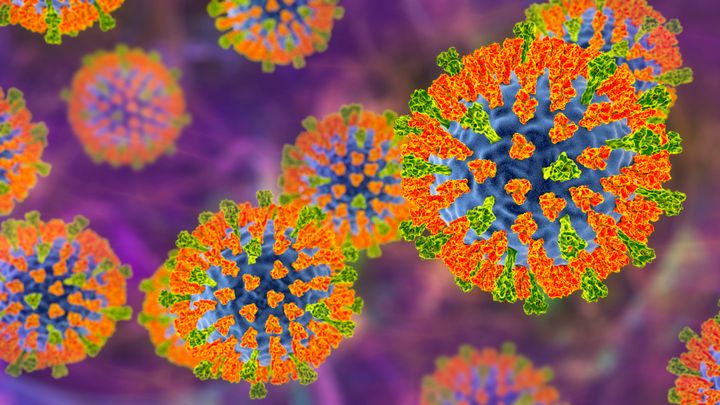Currently, Florida is experiencing a measles outbreak in which nine people, mainly children, are infected. Despite this, Florida Surgeon General Dr. Joseph Ladapo went against Centers for Disease Control guidance and told parents of unvaccinated children they can decide whether they want to keep their children home from school during the outbreak. The current recommendations state that unvaccinated children should stay home for 21 days after exposure.
Experts stress that measles isn’t something to dismiss — particularly for those who aren’t protected.
“What most people forget ― because we haven’t had a lot of measles in the United States for a long time ― is that measles can be a relatively serious disease,” said Dr. Mark Roberts, a distinguished professor of health policy and management and director of the Public Health Dynamics Lab at University of Pittsburgh School of Public Health.
Measles starts with respiratory symptoms like coughing and sneezing and progresses to inflamed eyes, high fever, mouth sores, rash and more severe issues, said Dr. Gary Reschak, a pediatrician at Northwestern Medicine Huntley Hospital in Illinois.
“130,000 to 140,000 children die of measles every year in the world where vaccination rates aren’t very high, and they don’t have vaccines,” Roberts said. Roughly 1 to 3 in 1,000 cases of measles results in death, according to the CDC. “Measles is not just a rash,” Roberts stressed.
Additionally, “when you get measles, it causes your own immune system to take a hit … a lot of the severe issues with measles are due to secondary infections taking over,” Reschak explained.
Most commonly, secondary infections like pneumonia, diarrhea and ear infections in children are reported, he noted. An estimated 1 in 1,000 cases of measles turns into encephalitis, or swelling in the brain, which can result in lifelong neurological damage.
All of this is obviously concerning. Thankfully, there’s an extremely effective vaccine that can help with this ― but the problem is that fewer people are giving it to their kids. What does that mean for us? Below, experts break it down:
More outbreaks will occur if measles vaccination rates continue to drop.
According to the CDC, roughly 93% of kindergarten students had their measles vaccine as of the 2021-2022 school year, and the target percentage is 95%. As a result, we’re seeing more and more of the outbreaks (like currently in Florida) in populations with high rates of unimmunized children throughout the country, Reschak said.
Roberts added that we’ve been lucky so far in that the outbreaks in the United States have not been very big. There were relatively small occurrences in Disneyland in California in 2014 and one in Ohio in 2022 — but if just one infected child comes in contact with a community with low vaccination rates, an additional 15 to 16 kids can be easily infected.
“So, it can explode relatively quickly if you happen to get people who are not vaccinated,” Roberts explains.
Measles spreads quickly, both experts said. “Measles itself as a viral infection is highly contagious — highly contagious in a way that I think most people don’t appreciate, especially [with] what we’ve just been through with cold, flu and RSV season, and, then of course, COVID,” Reschak said. “Measles is in, like, its own league in contagiousness. This is not washing your hands and everything is good … you’re not going to be able to wash your hands to get away from measles.”
Measles is spread through contact with an infected individual, Roberts said. This can mean through direct touch, in addition to sneezing, coughing and touching a contaminated surface like a desk or doorknob,
Additionally, measles lingers in a space long after the infected person leaves. For example, if you’re susceptible to measles, meaning you don’t have immunity or weren’t vaccinated, you could be in a room where an infected person was two hours prior and have a 90% chance of becoming infected with measles, noted Reschak.
Roberts added that the more infectious someone is, the more people you need to be immune to reach herd immunity — which is the amount of immunity you need in a population to stop the spread of an infectious disease.
“Measles is just about the most infectious disease that’s around … and you need about somewhere in the middle 90% of people to be immune before you get herd immunity with measles,” Roberts said.
Once you get below that 90% in a school, for example, you end up with large outbreaks stemming from one case.
Roberts ― who helps facilitate UPMC’s online measles simulator, which simulates the spread of measles in several communities throughout the United States ― said “When we did the work … with the actual vaccination rates and modeled what would happen … there were schools in the state of Texas that only had 40% of their children vaccinated. If you drop a case of active measles into a school that only has 40% of the kids vaccinated, it can explode — hundreds of cases can happen from that introduction.”
KATERYNA KON/SCIENCE PHOTO LIBRARY via Getty Images
The vaccine won’t be 100% protective for everyone. So if herd immunity isn’t achieved, more people are at risk.
Those most at risk are people who are not vaccinated against measles. The vast majority of people who are vaccinated will be protected. However, in certain cases, some people who are vaccinated may not be totally protected, according to Reschak.
The current measles vaccine schedule consists of two shots, one shot at age 1 and a booster dose at age 5. “The vast majority of adults who will be reading this went through a very similar process with the vaccine,” Reschak said.
After one dose of the measles vaccine, “you have a 93% chance of being immune to the measles.” But there’s a 7% chance that your body does not properly uptake the vaccine and you don’t develop immunity. This, he said, is a normal part of vaccines.
After two doses of the measles vaccine, that number goes up to 97%, meaning there is just a 3% chance you’re susceptible to measles. Thankfully, that is a low number, but it still does account for a portion of the population that does not know whether or not their body took to the vaccine.
Additionally, some children can’t get the vaccine because of a cancer diagnosis, immune disease or several other conditions, Roberts said. And just like with adults, certain children won’t produce any sort of immune response to the vaccine.
“The biggest risk for anyone to get measles is anyone under 5, anyone over 20 and the immunocompromised,” Reschak said.
Whether it’s a baby who is too young to get their first measles vaccine or an adult who is undergoing chemotherapy, the risks associated with measles are higher for these groups, he noted. Additionally, the CDC says pregnant people are also at higher risk of complications from a measles infection.
“This is where herd immunity comes into play. When only 3% of the population would be susceptible and everyone is getting their vaccine, you’re really not going to be exposed to measles. Measles doesn’t have a way to get passed around,” Reschak said. “But now, once the vaccine rates continue to drop … there’s enough unvaccinated people where they can continue to spread it around and around.”
The best way to protect yourself and your loved ones from measles is to get vaccinated, Reschak stressed. “But again, it is scary because there is that 3% chance that even though you think you’re properly vaccinated, you still have a chance of being susceptible to measles,” he noted.
If you are vaccinated, it is more than likely that you are protected, but if you really want to confirm, you can contact your doctor who can arrange testing to make sure you have immunity. But Reschak stressed this is not necessary for the average person.
Continuing to let unvaccinated kids go to school will increase risk.
“If you choose to let people continue to go to school, you’re not only putting the child who chooses not to be vaccinated at risk, but you’re also putting children who cannot be vaccinated or not protected at risk,” Roberts said. “That’s why I personally believe it’s a public health question more than a personal decision question. As a public health expert, we have a responsibility to protect everybody in the population.”
Bottom line: The measles vaccine is safe and is an important public health measure. Misinformation has kept people from getting the shot for their children in recent years, but Roberts stressed that it’s a safe shot and “hundreds of millions of people have had the vaccine.” Plus, it provides lifelong protection from measles.
“This is a well-established, safe and effective vaccine. And, of course, there’s all that misinformation that’s been around for years now, but if you have any concerns, talk to your provider or your child’s pediatrician and they can get you the real information,” Reschak noted. “Don’t let something you read on the internet or saw on TikTok keep you from keeping your children and family safe.”


